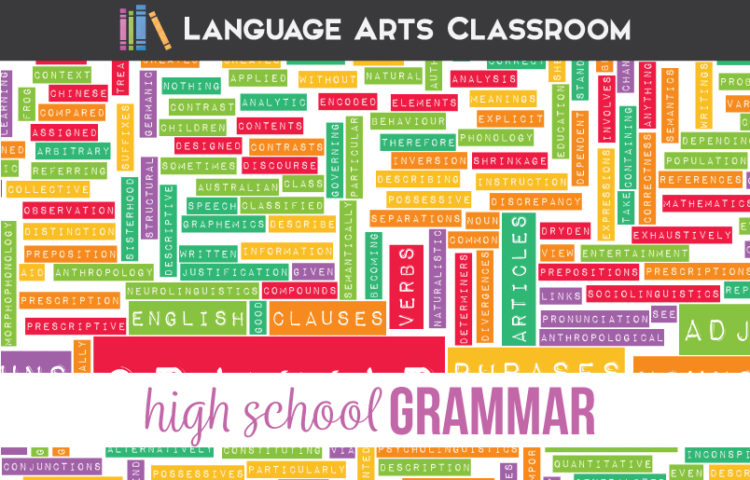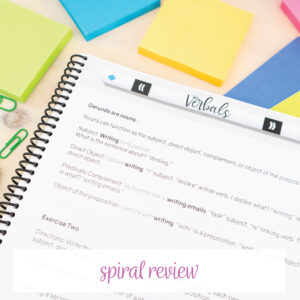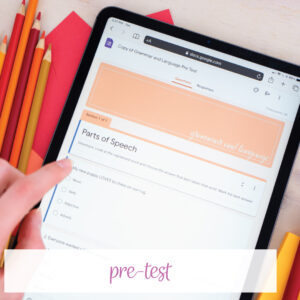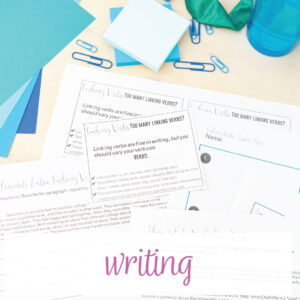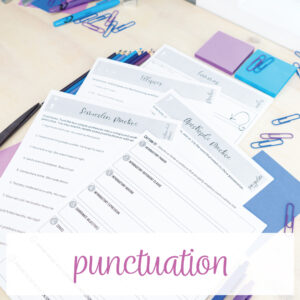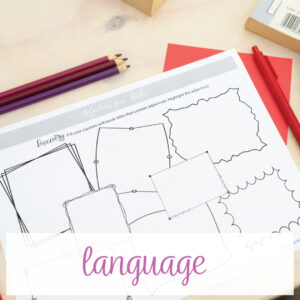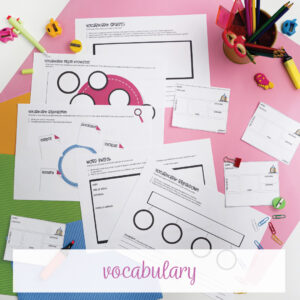What are the most important grammar rules to teach in high school?
The most important grammar rules to teach in high school include subject-verb agreement, proper use of punctuation, sentence structure, verb tenses, and commonly confused words. These grammar concepts are in most standards, too.
English grammar bridge: middle to high school
Language changes, evolves. As students finish middle school grammar, they will move to a more analytical approach with high school grammar lessons. Therefore, high school grammar activities must reflect that shift from memorization and lists to application and analysis. If you are looking at those standards and wondering how grammar activities for high school will fit into your teaching block, I understand. Those higher standards are intimidating.
As a teacher, the language standards for high school are dense. As a teacher, I don’t want to scare off potential writers, and I don’t want students to feel overwhelmed. A goal of mine is for grammar lessons for high school to connect to other parts of class. Often, we accomplish this goal through writing and other times, through vocabulary lessons.
I broke down the largest concepts in high school language standards and outlined some grammar instruction points below. Take the ideas that you can implement into your lessons, and make them your own!
Pronoun, conjunction, verb, noun, adjective: the review
After meeting your classes, you might decide that a brief grammar review is necessary. Grammar lessons for high school might require everyone to be on the same page with basic concepts.
It will be a rare circumstance that older students have not heard terms concerning parts of speech or parts of a sentence. Approach material with older classes as an opportunity to learn advanced pieces of the basics. For instance, classes that study clauses probably need to review subjects and verbs.
Classes that study parallelism will need to review different parts of speech. Attach the review concept (often from earlier years of schooling) to the new concept (grade-leveled standards).
Phrases
A phrase is a group of words that does not contain a subject and a verb. High school students have covered verbal phrases, prepositional phrases, and appositive phrases by the time they get to high school. The standard is for students to use various types of phrases (noun, verb, adjectival, adverbial, participial, prepositional, absolute).
Well, again, part of your grammar activities for high school might include a refresher of what all of those words mean. I overall do not spend must time with identification of those types of phrases. Students should have studied most of them in previous grade. Plus, since students are using those phrases, my primary concern is that students put them in their writing and punctuate them correctly. If high school grammar includes a review of phrases, I review phrases with writing.
For instance, a participial phrase contains a participle and its modifiers. They are great to add variety to sentence structure. After covering the definition with students, I would write sample sentences with them. For instance:
Exhausted from track practice, Jace fell into bed.
My discussion with students would include: “Exhausted from track practice” is a participial phrase modifying “Jace.” Since the participial phrase modifies the subject and is an introductory phrase, it needs a comma. Could we move the participial phrase to another part of the sentence?
Jace, exhausted from track practice, fell into bed.
Then I would discuss with students which sentence conveys the meaning in the best way—I would ask them to evaluate the writing we did together. There really isn’t a right answer here; students should be able to discuss language though.
Finally, I might transition into a discussion about clauses. Can students turn the phrase into a clause? What would be necessary for that to happen?
Jace was exhausted from track practice, so he fell into bed. Now we have a compound sentence. Which is better: the simple sentence with a phrase or the compound sentence? Again, there is not one answer. Students should be able to evaluate the effect of phrases and clauses though.
Clauses
Clauses are groups of words that contain both a subject and a verb. I devoted an entire blog post to clauses in which I detailed talking points, activities, and scaffolding practices. Middle school students have worked with dependent and independent clauses because they have studied sentence structure.
High school grammar activities, however, take the study of clauses deeper than middle school. The goal includes that students can use noun, relative, and adverbial clauses with purpose. Think of what students probably need to review:
- Ways a noun functions in a sentence.
- What relative pronouns are.
- Questions adverbs answer.
You might dive into clauses lessons and realize that you need more scaffolding, but that list is a start of how to introduce clauses.
Since students will be writing the clauses, I encourage them to keep their lists and definitions handy. Plus, I use hands-on pieces (pictured above) to create sentences with students. They already do write clauses, but the pieces help remind them that they are capable of using them purposefully.
Connection to writing
Grammar lessons for high school should show a direct connection to student writing. Hopefully, you are writing samples of the concepts that you are teaching as you move through clauses and phrases. Still, those lessons are contrived. The true test is if students can apply those concepts to their own writing.
This concept might seem intimidating if you have never purposefully looked for grammatical concepts in student writing. When I teach writing, I use the application of phrases and clauses as an opportunity for differentiation. Sometimes, I ask students to implement two types of phrases and one type of clause (other than independent, obviously) in a paper. Other times, I allow students to choose what they will include.
Another method of connecting grammar to student writing is to look at students’ finished papers. Ask them to modify their sentences with the addition of phrases and clauses that will strengthen their message. This process also encourages additional editing and revising.
Punctuation: comma, semicolon, colon, apostrophes
More difficult pieces of punctuation like the semicolon and colon are in high school language standards. Again, I review the basics, like how to use them in sentences.
Then, we create goofy sentences together and evaluate their use:
- Mrs. Moss loves cake; her husband prefers ice cream.
- Not only does Mrs. Moss eat cake, but she also eats ice cream.
- Mrs. Moss is not picky about her dessert: cake, ice cream, and pie are all wonderful.
Then, ask students to use those tricky punctuation marks in their own writing.
Finally, be aware your classes might need spiral review. Comma rules are tricky, but even basic punctuation rules like apostrophe use might need to be reviewed. Grammar lessons for high school require flexibility.
Language
The most difficult piece of high school grammar lessons to articulate (for me!) is the overall concept of language and its beautiful changes. When I work toward meeting this standard, I often pull out an assortment of books. Sometimes I pull a variety of young adult literature and other times, I pull picture books.
Why? Well, books that students understand and remember provide the perfect opportunity to show the change of language. High school grammar activities that include literature students understand will help you show the differences in language. Consider:
- How do authors use language with younger audiences? What about young adults?
- Look at publication dates of books. How do books from fifty years ago use language? Does any of it make you uncomfortable today? Are connotations of words different?
- Reread some of the dialogue. Is it simple? Dated? What sentence structure, phrases, and clauses led you to those conclusions?
The more you can connect language to everyday life, to what students already know, the more they will realize that language is ever changing.
Vocabulary
Language standards encompass more than grammar. So while we work on grammar lessons for high school, standards ask us to discuss connotation, terms, and manipulations. Don’t look at the standards as making these lessons increasingly difficult. Instead, be sure that your activities incorporate multiple concepts which will then show students the importance of language.
Vocabulary and grammar lessons go hand in hand when it comes to understanding language. By focusing on vocabulary, students can expand their knowledge and enhance their communication skills. Once you have vocabulary words, practice them in a variety of ways.
One effective way to teach vocabulary is through context clues. Encourage students to pay attention to the words surrounding an unfamiliar term in order to decipher its meaning. This not only helps them understand new words but also builds their overall reading comprehension skills.
Then, manipulate the words—turn a noun into an adjective. Take a list of vocabulary words and practice parallelism. Discuss the connotation of certain words. The more interaction and discussion students have with vocabulary concerning grammatical terms, the more students will understand both.
Secondary Prep Time!
If you are overwhelmed by organizing grammar lessons for high school classes, take a step back. Evaluate where your students are, look at your standards, and proceed. Looking at previous standards, at where your students have been, decide the pieces of review that will help you meet current standards.
As I mentioned, grammar activities for high school can be difficult, but the payoff is in student writing and class discussions. Don’t be afraid to experiment with language. Use hands-on grammar pieces and authentic writing assignments to meet language standards.
Grammar lessons for high school can feel overwhelming to the teacher! If you’d like to join a group of like-minded teachers to discuss grammar, find Grammar Gurus on Facebook.


